by Winding Pathways | May 1, 2025 | Birds, Flowers/Grasses, Nature
A woodland stroll is outstanding in any season but is best during May’s first ten days. We always marvel at nature’s fleeting changes that happen swiftly.
Why Early May
Late April and early May are when ephemeral flowers revel in their time in the sun. That long word “ephemeral” means a short time. There’s a brief time in late April through about mid-May when the air and soil are warm but trees haven’t yet leafed out. So, sunlight streams through still naked branches to reach the ground.
Bloodroot, trout lily, anemone, Dutchman’s breeches, ginger, trillium, and May apples, among many of the woodland flowers, take advantage of this window of sunshine. They grow amazingly fast, bloom for a short time, and then seem to disappear for the rest of the year. They are there but hard to see and not in bloom during summer’s heat and winter’s chill.
-

-
An early bloomer
-

-
Trout Lily can form carpets in dappled shade.
-

-
Mayapples carpet the forest floor.
-

-
A sunny center surrounded by white petals.
-

-
Bunchberry forms a lush, carpet on moist soils.
-

-
When broken, the stem oozes a reddish sap.
Other Delights
Enjoying wildflowers is only one of early May’s woodland delights. Another is birds.
Many of them are, like wildflowers, ephemeral but in a different way. They are migrants en route from points way south to breeding areas up north. For only a few days, often in early May, they linger to feed, rest, and sing before continuing their journey.
We always look forward to seeing migrating birds on their way north and others that come north to nest near our home. Flowers are easy to find. They can’t hide. Birds can, and often many fascinating birds are hard to spot but easy to hear as they sing in what seems like springtime joy.
-

-
Bird watching is again a joy with hearing aids.
-

-
A catbird drinks by a pool.
-
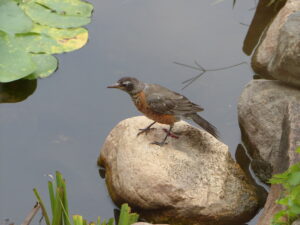
-
Keeping a wary eye, the robin cautiously gets a drink.
-

-
Hummingbirds zoom up, down, and sideways all summer. Then, head south.
-
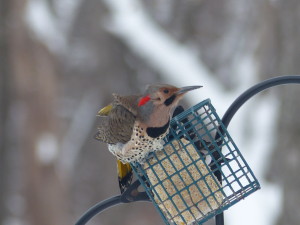
-
Winter is tough on birds so keep your feeders full.
-

-
A hooked rug by Yvonne Fellows
Modern Technology Helps
Identifying flower and bird species is a fun activity that modern technology has made relatively simple. We use phone apps to help identify plants and birds. Many are free.
Plants: SEEK is amazing. SEEK is part of an electronic world called iNaturalist. It works for many domestic plants as well as wild ones. Load the app, open it when encountering an unknown plant, take a photo, and SEEK can usually accurately identify it.
Birds: We love the Cornell University Lab of Ornithology’s Merlin Bird ID app. It includes a sound identification tool. So, when we’re in the woods, prairie or marsh and we hear birdsong we can’t identify, we turn on Merlin and select the sound feature. It identifies what’s singing. Merlin also includes photos and information on each species.
We hope you take in the annual show. Early May is the best time to be outside. Enjoy and remember.
by Winding Pathways | Nov 14, 2024 | Birds, Nature

Turkeys sweep up all available seeds.
While feasting on a recent turkey dinner we glanced outside to see enthusiastic hungry wild turkeys trotting towards us. Hunters consider the gigantic birds wary and elusive. Ours aren’t. Whenever we scatter birdseed, they dash from the woods and sometimes even follow us when they see us carrying the can that holds seed.
Turkeys are fun to watch and delicious to eat. Beef, pork, lamb, and chicken all originated in the Old World and were brought to North America during early settlement days. The turkey is the only major American native food animal that’s today eaten around the glove. It took a double route to the dinner table.
Turkeys Crossing the Ocean…
Early European explorers discovered wild turkeys in the vast forests of eastern North America and watched their domesticated cousins scratching around Native American villages, especially in Mexico and Central America. By the 1500s sailing ships bearing live domestic turkeys were heading for Europe, where they soon became an esteemed food. Today, European farmers produce about 13 million tons of the tasty birds.
…and Back Again
A century or so after being introduced to Europe, the Pilgrims brought domestic turkeys with them when they crossed the Atlantic westward. For the turkey species, it was their second ocean crossing. During the next 250 years, Americans ate both wild and domesticated turkeys.
Too Much of a Good Thing
They overdid it. Overhunting, combined with massive habitat destruction, reduced wild turkey numbers to around 30,000 by the early Twentieth Century. Although millions of domestic turkeys lived on farms, wild ones survived only in remote forests and swamps. They seemed on the verge of extinction.
Help for Endangered Turkeys
That quickly changed. Thanks to the efforts of the National Wild Turkey Federation and state wildlife agencies, turkeys made a remarkable comeback. Flocks were captured, moved to places that seemed suitable for them, and released. They quickly multiplied and began expanding.
When we moved to Iowa in 1978 biologists believed the husky birds could only survive in large forests. Iowa only has a few big woods where wild turkeys were released. Soon the birds proved the experts wrong. They began expanding and even moved into cities and towns. Wild turkeys are so common today that efforts to catch and move them to new habitats aren’t needed.
Turkey Sub-Species
The National Wild Turkey Federation’s website includes much about the history and habits of this remarkable bird. According to them, turkeys live almost coast to coast from Canada to Mexico in five subspecies.
The Eastern wild turkey lives across about half of the eastern portion of the United States. It has chestnut brown tips on its tail feathers. Gobblers can reach 30 pounds and sport a long beard. Hens are much smaller and sleeker.
The Osceola wild turkey makes its home in Florida. Its tail feathers are tipped in brown on a bird that’s smaller than the Eastern.
The Rio Grande’s tail feathers are tipped in tan. It’s also a smallish subspecies with only a medium length beard.
The Miriam’s sports white-tipped tail feathers. It lives in the mountain west. Although it has a short beard it can be as large as the eastern subspecies.
Finally, there’s the Gould’s wild turkey that only lives in Arizona, New Mexico, and parts of Mexico. It is the rarest subspecies.
There is also a totally separate wild turkey species. It’s the Ocellated. This gorgeous beardless bird lives only in southern Mexico, Belize, and Guatemala.
Turkey Behavior Entertains

Showing off.
We never tire of hearing wild turkeys’ springtime gobbling, watching them strut, and sometimes spotting them fly up into tall trees in the late evening. How they keep warm enough to sleep in their treetop perches during blizzards astounds us. Turkeys are also fun to watch at our feeder, although they gobble up so many seeds there’s little left for smaller songbirds.
by Winding Pathways | Nov 7, 2024 | Birds, Chickens, Garden/Yard, Nature
Cardinals and other birds visiting wintery backyard feeders need grit. They’ll appreciate finding some near the sunflower seeds and millet.
The old saying that something’s as scarce as a hen’s teeth is as true for the chickadees, cardinals, and goldfinches that visit backyards as it is for the hens in our coop. Birds have no teeth. Before they can digest coarse corn and wild seeds it must be thoroughly chewed. How do they do it?
What Is Grit?
Seeing birds along wintery roads solves the mystery. They’re picking up and swallowing tiny pieces of rock that will descend into their gizzard. A gizzard is a powerful muscular pouch that grinds tough seeds against grit, resulting in a seed slurry that then moves through the bird’s digestive system. Grit is a bird’s teeth.
When Is A Good Time to Spread Grit?
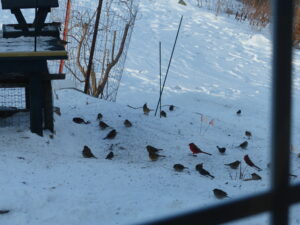
Birds flock to the seeds.
During warm months birds have no trouble finding tiny stones in bare patches of earth, but when the world is blanketed in snow or ice, they can’t find grit. Winter is when they appreciate swallowing a few tiny stones near bird feeders.
What Types of Grit Are Best?
As we fill our feeders at Winding Pathways, we sprinkle grit in with seeds and dribble some on the ground. We use two kinds of grit. When we have it on hand, we prefer baby chick grit that we buy at a farm store. It is tiny pieces of sharp quartzite that’s especially effective in grinding seeds in a gizzard. It’s sized for tiny baby chickens, so it’s just right for backyard feeder birds. When we don’t have it on hand we use regular sand. Traction and kid’s sandbox sand both work well and can be purchased at most home supply stores.
How Much Grit?
-

-
Birds flock to the seeds.
-

-
Sprinkle grit once a week to help birds in the snowy season.
-

-
Spread grit when the ground is snow or ice covered.
Birds must have grit, but they don’t need much. A handful in and around feeders once or twice a week is plenty.
Other Uses
Grit’s useful around the house. When walkways are snow-slicked humans are mostly likely to slip and fall. Tossing grit on slippery walkways creates traction for people and may prevent a painful fall. Birds spot it there and occasionally pick up a few pieces. We keep about 50 pounds on hand and use most of it for traction and just a tiny fraction for our birds.
This winter when filling bird feeders scatter a bit of grit. Cardinals and other birds will appreciate it.
by Winding Pathways | Feb 22, 2024 | Birds, Mammals, Nature, Pests
We’ve blogged before about a white-footed mouse in the house. We read the story to our kids when they were little. Time after time we snuggled down with the book and they never got tired of hearing why the mouse might be cute but doesn’t belong in the house. A recent internet search for the specific book revealed lots of stories but not the one we wanted. Alas. So, here we are decades later writing again about a mouse in the house. Mice are cute but they do not belong in a house.

A person holding a mouse.
Whenever we’d find mouse evidence in our house, we’d set traps and usually catch a few, tossing their lifeless bodies outside for scavenger animals to eat. We do feel badly, but as the mother in the story said, “…a mouse does not belong in a house.”
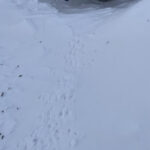
Path to the outdoor pantry
In January we changed our mind…..sort of. It was 20 below zero outside. Rich trudged through snow drifts to fill our bird feeders and noticed tracks, tiny mouse tracks, in the snow. A crafty white-footed mouse had scampered on top of the snow the night before to scrounge a few leftover seeds for dinner. Its tracks led to a snug nook out of the wind and under the deck.
An average White-footed mouse weighs a whopping .7 ounce. That’s seven-tenths of an ounce! That such a tiny creature can survive the howling wind and intense cold is a marvel of nature. Every nocturnal predator from coyotes to owls tries to capture and eat this diminutive mammal. But, it is wily, wary, and quick. Although not usually out during the day, it has to be mindful of cats and hawks looking for a meal.
-

-
Patience
-

-
Nocturnal predator
After seeing those tracks, we felt a bit sorry for the animal that made them. We still won’t welcome a mouse into our house, but we’re happy it lives just outside in a safe place under the deck. He’s welcome to any seeds the birds overlooked.
To learn more about White Footed Mice and many other wild animals check out Animal Diversity Web out of the University of Michigan.
by Winding Pathways | Feb 8, 2024 | Birds, Nature
We live in a world of dizzying change in how we live, drive, and communicate. Like many people, we struggle to keep up with change and stay modern, so it’s comforting to know that some things simply don’t change. Fortunately, winter owls don’t change.
In March 1982 the Cedar Rapids GAZETTE printed Marion’s column on Iowa owls. It’s as relevant today as it was 42 years ago.
Audible In Winter
Now is the season of Winter Owls. The time of year when they are especially audible and often visible. Owls have a large vocabulary from courting to warning. YouTube is a great source to learn about and hear the sounds.
Barred and Great Horned Owls
We love hearing the clear and somewhat chilling calls of Barred and Great Horned Owls that reach our house over the snow and through the woods on clear, frosty winter nights. These two species live near our home year-round, with Barred Owls the most common. You can tell the Great Horned call that is low and throaty. The Barred calls out the familiar, “Who cooks for you?” refrain.
-

-
Waiting for supper.
-

-
Injured owls find a safe home at the International Owl Center.
Screech Owls
A few times a year we drive to New Jersey to visit relatives and often are delighted to hear the two calls of a local Screech Owl serenade the evening. Its soft, haunting trill, called a tremolo, wafts over the lake. The “whinny”, think of a horse whinny, is territorial.
Northern Owls
Several of our friends trekked north this winter to see Great Grey and Northern Hawk-Owls. The Great Grey’s sound varies from a low-pitched “whoof” to an abrupt “meeh” to short screeches similar to a blue jay. The Northern Hawk Owl’s vocabulary ranges from high-pitched warbling sounds that carry across frozen landscapes to “chit-chit-chits” to a wimpy, scratchy screech. Think of a person with laryngitis trying to sing. All owls’ calls are amazing delights for those who wander outside and listen carefully on winter evenings.
-
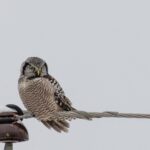
-
Northern Hawk Owl on wire. Photo Mark Ogden
-
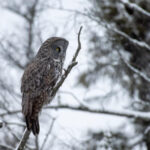
-
Great Gray Owl visits Northern Minnesota. Photo Mark Ogden
Snowy Owls
Many owl species don’t migrate much but these two sometimes dip southward from their usual winter range. So do magnificent Snowy Owls. In some especially frigid winters, they drift way south in what’s called an “irruption”. Birders flock to see them in open fields and even on the edge of airports! One of our favorite owls is the tiny Northern Saw-Whet Owl. They regularly come south in winter. Years ago, the Indian Creek Nature Center had a thick grove of young pines, a winter habitat the bird loves. Often, we could approach them closely on cold days. We even heard them once in the tiny ‘pine grove’ at our former residence.
How Do I Love Thee?
A fascinating aspect of owls is that they court and nest when it’s still winter! Although people rarely see courtship or mating, it is fascinating. Texas Backyard Wildlife captured video and the offering to the bigger female as a token of Love.
What prompts these impressive raptors to court, breed, and endure the hardships of incubating eggs in nature’s most desolate time of year? Necessity! Baby owls are a lot like human babies. They take a lot of care. For months owlets cry, eat, sleep, and poop. All the while growing. Just like humans. Young hatch late March into April when small rodents, the mainstay of owls, become more plentiful. Then, the adults really get busy foraging to feed the young tucked into nests of sticks.
Nests
Unlike some birds, Great Horned owl nests are not works of art. Adults return to the same wood tracts year after year and add only a few extra twigs. Young, like many teenagers, can make a shambles of the nest. The more practical Screech Owls prefer tree cavities and can be convinced to nest in wooden boxes adapted for them.
Parenting
During winter owls can be noisy and obvious as they wing across snowy fields at dusk. But after courtship and nesting, they quiet down. Like human adults, they are busy raising the young. By mid-summer people sometimes find “teenaged” owls flopping around on the ground or perched precariously on low branches. Like all fledglings, they are learning to fly. It’s best to leave them alone. The parent is nearby and the “kids” will make it without our help.
-

-
Waiting for supper.
-

-
Grounded.
Tuck In and Read!
Winter is more than a time to hear and see owls. It’s a season to read about them. Our two favorite bird magazines featured owls in their winter 2024 editions. BIRD WATCHER’S DIGEST, features a species profile on Barn Owls. LIVING BIRD includes a fascinating article called HUNTING BY HEARING. The magazines are available online to subscribers. We enjoy both while curled up with the paper copy by the wood stove, and occasionally reading online articles. We also browse reliable internet sources and YouTube videos on owls.
Be Intrepid!
For intrepid winter visitors a trip to the International Owl Center in Houston, MN, is a delight. Their signature event, the International Festival of Owls is scheduled for March 1-3 this year.
-

-
All things owl.
-

-
The International Owl Center promotes owl awareness.
Enjoy Winter
It’s winter. A season to enjoy the cold, snow, and OWLS.
by Winding Pathways | Jan 18, 2024 | (Sub)Urban Homesteading, Birds, Nature, Pests
Frustration Yields to Creativity
Reprising the blog on thwarting House Sparrows. Here is a recap of our initial frustration and subsequent ways to encourage native birds and discourage exotics.
As we wrote earlier, hordes of House Sparrows almost made us give up feeding birds. We’d fill our feeders each morning and hope to watch juncos, cardinals, chickadees, woodpeckers, and nuthatches visit on cold winter days. Unfortunately, hordes of House Sparrows began arriving. We don’t mind feeding a few, but dozens soon devoured all the expensive seed, leaving empty feeders for native species.
Coming Up Short on “Expert Advice”
We asked bird experts what we might do to discourage House Sparrows and tried several of their ideas. Nothing worked well, so we experimented and came up with a few tricks that seem to discourage House Sparrows to a degree yet let other species eat. Our tricks aren’t perfect and sparrows still come, but not in huge numbers.
Here’s what we did:
Altered filling time:
We noticed that cardinals, jays, chickadees, and nuthatches visited feeders in the early morning and late afternoon, but House Sparrows came more late morning and toward the middle of the day. So, we put out small amounts of seeds early in the morning and again in late afternoon. Often our feeders are empty mid-day when the house sparrows prefer to visit.

Eating from platform feeder
Sparrows enjoy feeding on the ground, on horizontal tables and other flat surfaces, and from silo-type feeders with long perches and large openings. We took down our standard silo feeders and replaced them with a silo shape feeder made of hardware cloth with a quarter-inch mesh.
In our quarter-inch mesh feeder, we put a mixture of black oil sunflower seeds and hulled peanuts. Native birds seemed better able to extract the sunflower from the mesh than House Sparrows. The peanuts don’t fit through the mesh, but many native bird species peck at them through the wire and extract pieces of peanuts. House Sparrows seem less able, or willing, to do this.
We also stopped feeding cracked corn and millet on the ground. Sparrows love them. Instead, we now toss full kernels of corn on the ground. Sparrows can’t swallow the big seeds and are unable to peck them apart. Woodpeckers, cardinals, blue jays, and nuthatches swallow or carry away the big seeds.
Put up with some House Sparrows
Our system helps deter these pesky exotic birds but is far from perfect. House Sparrows still visit and eat seeds but not as many as before we started using these tricks. Maybe they’ll work for you.
A few of you have shared. Now Others Can Share.
Winding Pathways is eager to learn other ways to deter House Sparrows. If you have discovered something that works, please let us know.
#






























